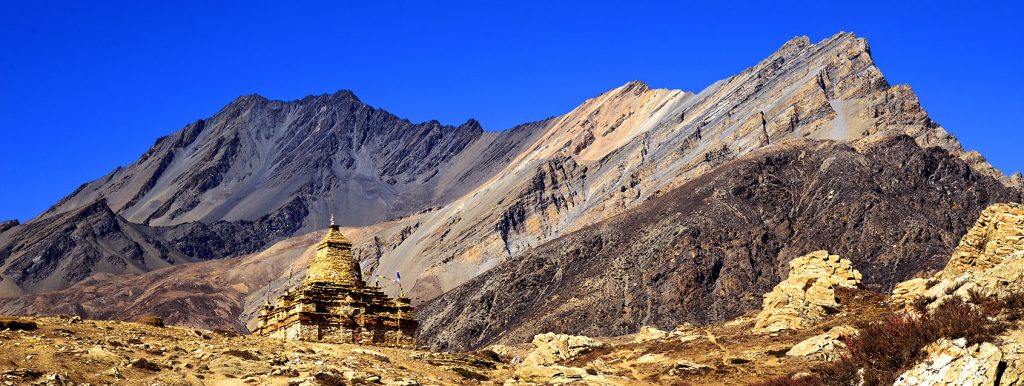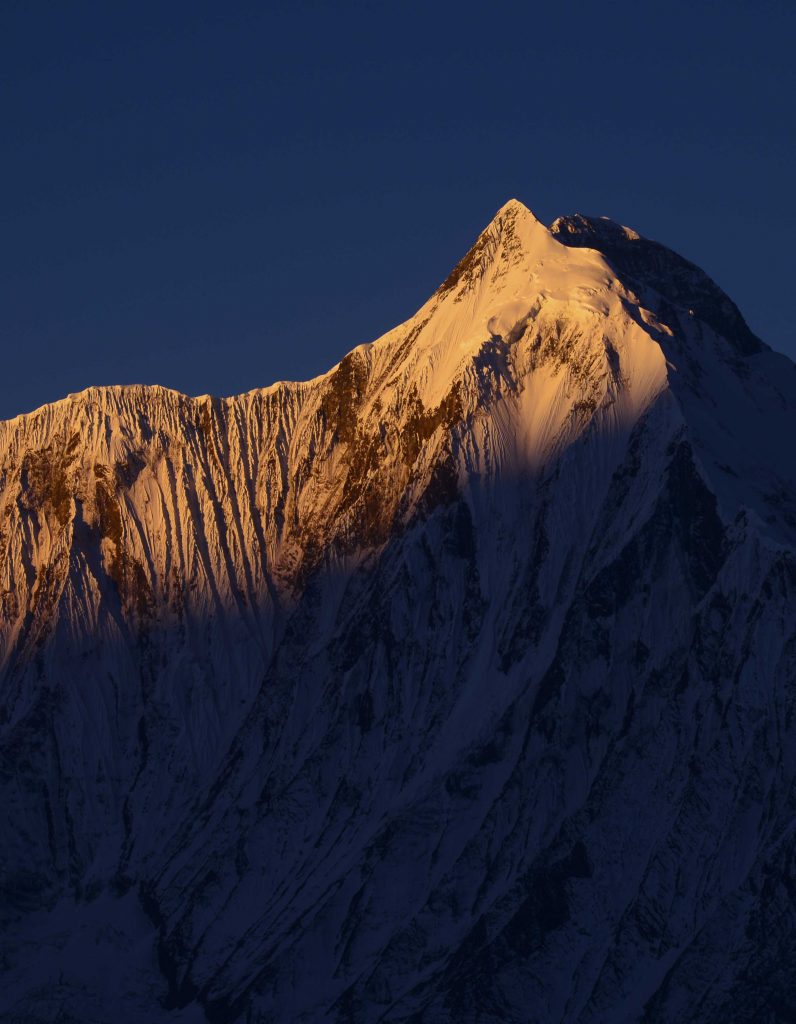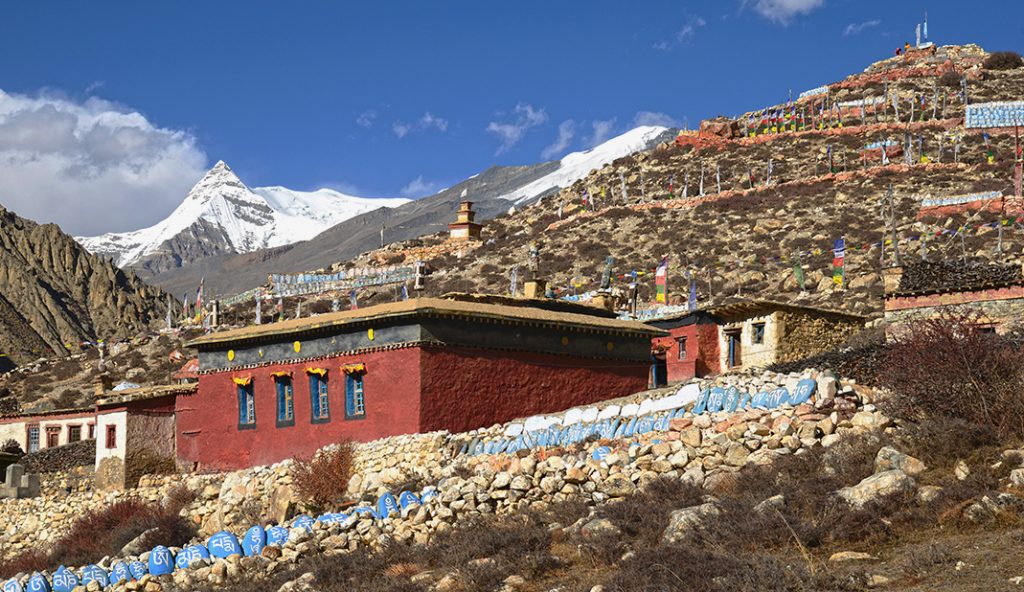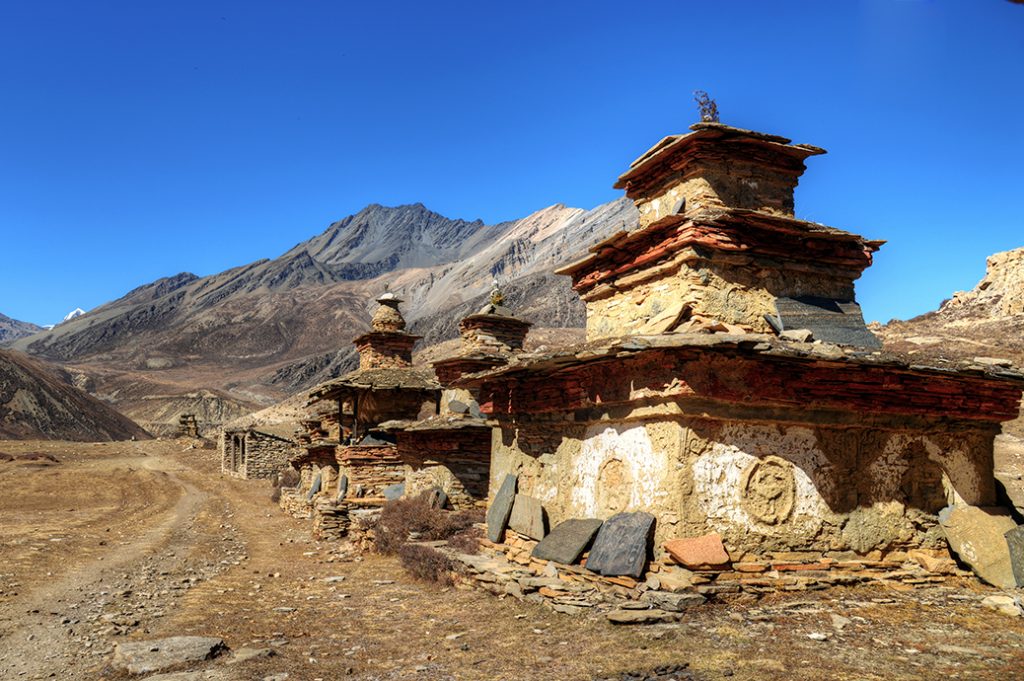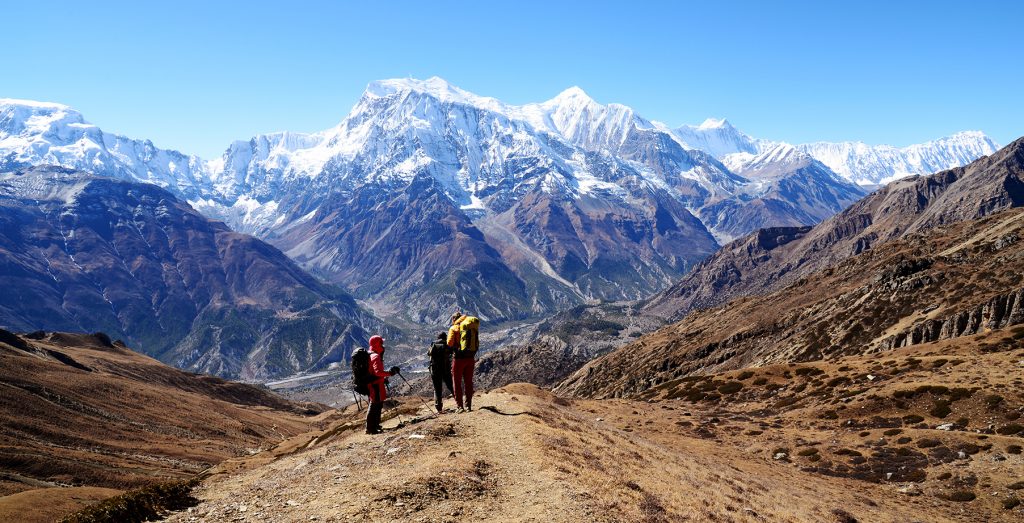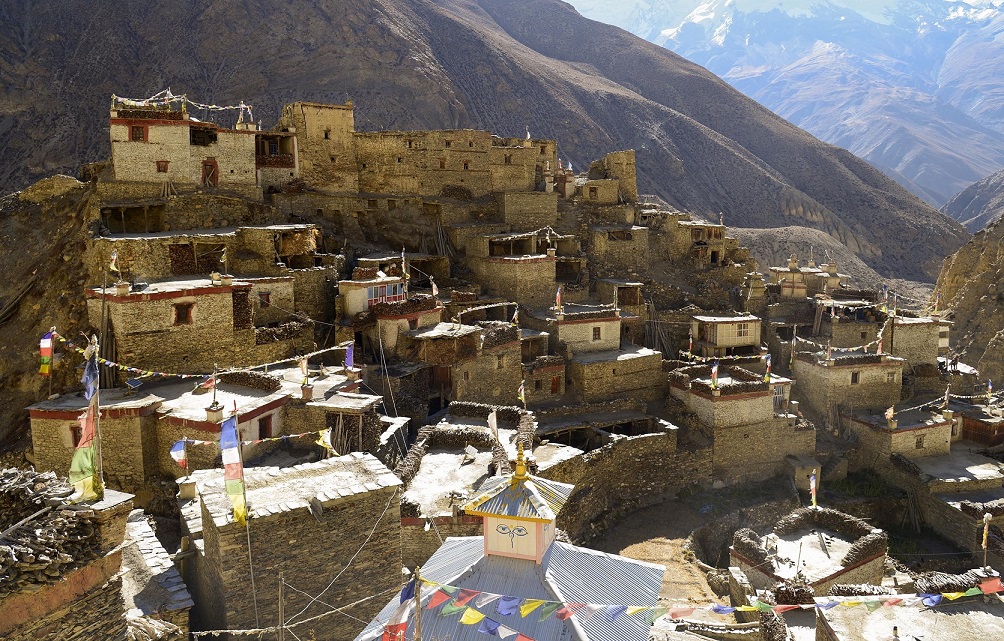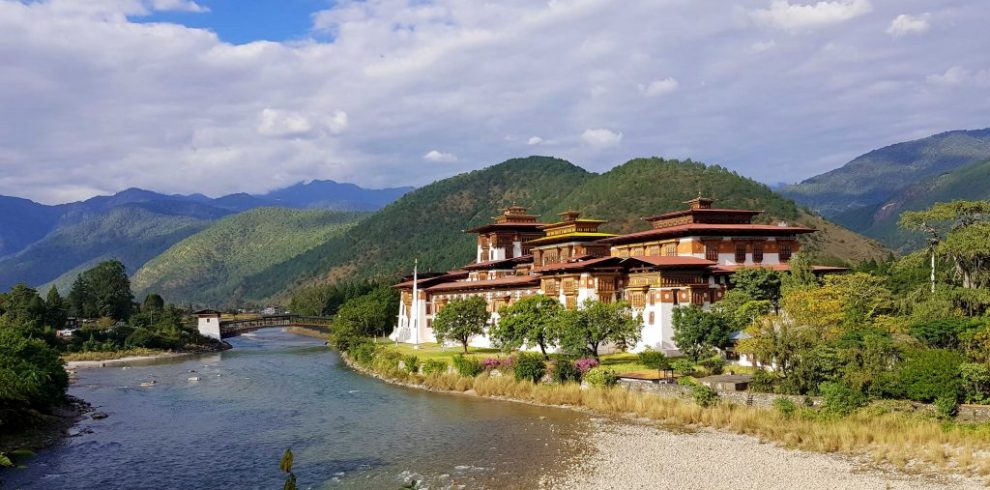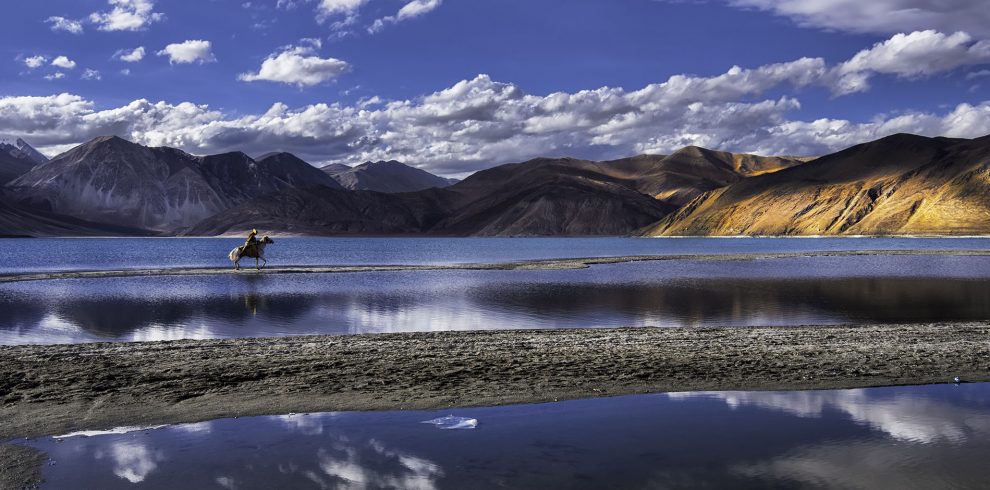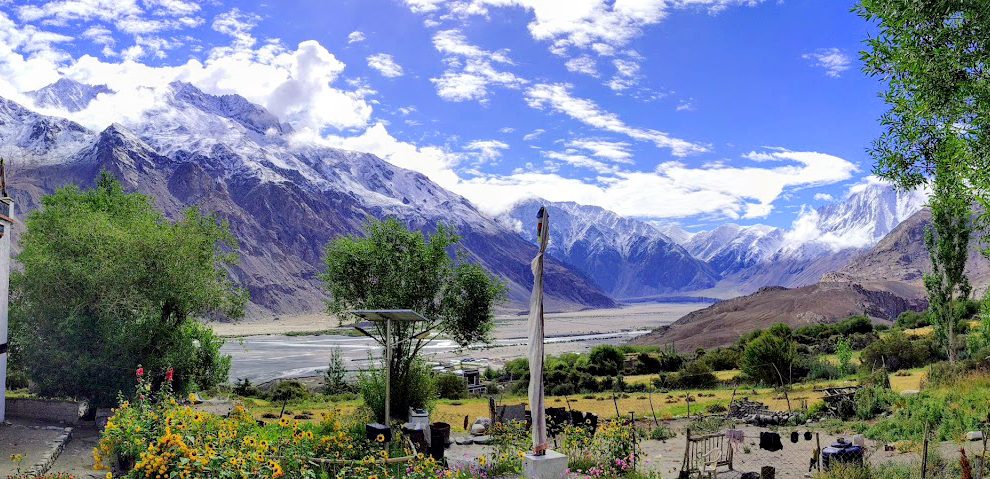“The village looked like a tiny fortress-citadel, for defense against bandits and to avoid wasting a single square foot of scarce arable land, it had been built on a 100-foot rock outcrop that fell sheer to the banks of the river. Most of Phu’s 38 houses clustered on top of the outcrop or clung to its sides like swallows’ nests; but a few spilled over a neck of land that joined the mountain behind the village…” – Cloud-Dwellers of the Himalayas by Windsor Chorlton.
Embark on this extra ordinary journey with you that takes you hundreds of year back in time. Explore this mysterious and fascinating land with its intriguing history and culture along with unparalleled mountain views, and capture the magical stories with your lenses under the guidance of your mentor Karissa Frye.
Overview
Your Adventure
Nar Phu Valley Trek is unarguably one of the most remote and least explored treks in Nepal. Opened only in 2003, this trek takes you to the wild, exotic and sparsely populated valleys of Nar and Phu, offering intriguing medieval Tibetan culture and customs completely undisturbed form, and dramatic mountains view.
Nepal’s most unscathed, Tibetan-influenced quarters, the restricted area of Nar Phu Valley can only be accessed with a special permit issued by an authorized trekking agency, who will also provide the obligatory guide. The permit is only valid for seven days so you must complete the trek in this time frame.
Beginning the Journey
We start our journey with a drive to Chyamje, a small village in the main trail of the Annapurna Circuit trek, and then branch off from Koto to follow an off the beaten track to Nar Phu valley, following the deep narrow river gorge, North of the Annapurna range.
After a week exploring and acclimatizing in these mysterious valleys with alpine forests, deep and Narrow River gorges, intriguing ancient Tibetan Buddhist culture and amazing wildlife with a possible chance of spotting the Snow Leopard (if you are lucky), we reach a village called Nar.
From here a barren trail leads to a high camp at Kang La Phedi (4530m). A gradual and steep climb from high camp leads to the Kang La (5320m) from where you get a surreal view of the Annapurna ranges and the beautiful Manang Valley to the South.
The trail then descends a steep terrain leading to Ngawal (3615m). Here we join the Annapurna Circuit trail and then retrace our trek back to Chyamje.
The surreal view from the Kang La.
Kang La pass at 5320m connects the wild, rarely-visited, valleys of Nar and Phu to the Annapurna Circuit. We can witness large panorama peaks right in front of us from Kang La Pass.
The ridge in front of you consists Lamjung Himal, Annapurna II, Annapurna IV, the summit of Macchapuchare (it peaks from behind the ridge), and Annapurna III, all of these will be your eye pleaser. The ridge then connects with Gangapurna and further down it connects with the highest of the Annapurna’s, the Annapurna II.
We can see the Annapurna range from the north. Usually, we see this range from the southern side, from the Pokhara side, the Annapurna Base camp, but from here we see the range from the North.
This place is called the Grand Barrier, and if you continue further down, you can also see Dhaulagiri near the end of the ridge. You can also find a lake below Kang La at 5220m.
Highlights
- Discover the isolated settlements of Naar and Phu
- Superb “off-the-beaten-track” trekking
- Learn how to shoot adventure photographs under the guidance of your mentor Karissa Frye
- Opened to trekkers only since 2003
- High snow-peaks, ancient Khampa settlements with intriguing cultures and traditions
- Exotic hidden villages of Nar and Phu
- Ancient monasteries
- Crossing the Kang La Pass with magnificent views of the Annapurna.
- Possible sighting of the Snow Leopard and blue sheep
Itinerary
Once you reach KTM airport and finish with the immigration and custom formalities, walk out of the Exit door into the passenger pick up area you will see hundreds of people with different sign boards. Please look for Hi On Life Adventures sign board. Once you spot it, walk straight to the signboard and identify yourself. From here we will take care of you.
When you arrive to your hotel you will be briefed about your activities and “do’s and don’ts” while your stay in Kathmandu.
In the evening we will go for a traditional Nepali dinner at Kathmandu’s finest Nepali restaurant to end the day.
After breakfast you will be taken for a half day city tour where you will be visiting some historical temples and monuments. You will end your sightseeing with a lunch.
After your lunch you will be return to your hotel and your Group leader will give you your trek briefing and issue you your ‘trek pack’ consisting of a duffle bag, down jacket, sleeping bag, inner liner for your sleeping bag and rain poncho.
Your afternoon is free for you to do your packing and purchasing your last minute items for your trek.
Early morning drive towards west from Kathmandu, following the winding road over the valley alongside the Trishuli River brings us to a small bustling highway junction called Muglin. Here we cross a suspension bridge and leave the East West Highway and continue on the Prithvi Highway that connects Kathmandu and Pokhara. After the suspension bridge over the confluence of Trishuli and Marshyangdi, we drive alongside the Marshyandi River towards Pokhara until we reach a town called Dumre which is 148 Kms from Kathmandu. On a clear day, the mighty ranges of Annapurna, Ganesh and of Manaslu are intermittently in view. Here we leave the Prithvi Highway and turn North and drive 36 kms on a narrow road to Besisahar. It will take us approx. 5 to 6 hours from Kathmandu to reach Besisahar.
Besisahar is a fairly large bustling town with plenty of tourist lodges and restaurants. This used to be the starting point of the Annapurna Circuit trek before the construction of the road. From Besisahar we need to change our vehicle to a 4 wheel drive jeep and drive alongside the Marshyangdi River on a dirt road for 42 kms to reach Chyamje. It will be a tiring day with a long drive specially the rough road from Besisahar to Chyamje, so we take an early dinner and call it a day early.
Right after we commence our trek after breakfast, we leave the jeep road and cross to the other side on a suspension bridge and start climbing stone stairways through a forest for about 2 hours with the river tumbling through a maze of large boulders. After reaching the top of the zig-zag climb, the valley suddenly widens out to reveal the village of Tal, which nestles amongst the fields of barley, wheat and potatoes. We have now entered the district of Manang. We will stop at this village for lunch. There is a beautiful waterfall in this village. You can take a bath at the waterfall while you wait for lunch.
After lunch we walk past the village along the bank of the river and cross a suspension bridge to meet the jeep road on the other side. An easy walk along the road passing several small restaurants and small Rainbow trout fisheries brings us to a village called Dharapani. From Dharapani we walk along the wide jeep road for an hour to reach Bagarchap (2160m), the first village on the trek with typical Tibetan architecture. Here we may observe firewood stacked on the roofs in preparation for the long, hard winters. Excellent views of Lamjung Himal 6983m, Annapurna II 7937m, and Annapurna III 7555m, can be seen towards the west and Mt Manaslu 8156m, Peak 29 7871m, and Himalchuli 7893m, can be seen towards the East. There are many apple orchards in this village and around this area. Our lodge for the night is in the midst of the apple orchard.
We begin with a gradual climb steadily through a dense forest. There are beautiful waterfalls along the trail. After 3 hours walk we reach Timang where we stop for lunch. Again breath taking views of Mt. Manaslu, Peak 29 and Himalchuli can be seen from here. After lunch we continue through the coniferous forest to an amazingly beautiful village of Thanchok. It is an old Tibetan style village with beautiful terraced fields and apple orchards. After Thanchok, we again meet the jeep road and an easy trek for an hour reaches Koto. Koto is a small bustling town with several lodges and a police check post. Koto is a junction for the Annapurna Circuit main trail and the Nar Phu Valley trek. Restricted area permits are checked for Nar Phu Valley. We stay here for the night.
Today we start early, as there is a lot of distance to cover. Right after the check post we cross the Marshyangdi River and enter the remote valley of Nar & Phu through a narrow canyon.
We trek through beautiful pine forest following the Nar Khola in the canyon, past small cave shelters and pilgrims’ resting places called Dharmasalas. We stop at one of these pilgrims resting place in the forest for lunch. The trail is narrow which is cut through near vertical rock massifs in the canyon. Emerging from this narrow canyon, the trail passes under a wide waterfall. Suddenly the forest becomes thinner and the landscape wider. The last stretch into Meta involves climbing a steep hill. Meta lies on a big open cultivated field and consists of a few lodges, which are simple but clean and offer good meals.
From Meta , the trail meanders along the ridge passing some of the unique, colorful Tibetan Buddhist chortens that Nar and Phu are famous for. The trail is easy following the contour and is marked by spectacular shapes of very old juniper trees and colorful bushes along the sides. This day in particular is very beautiful with huge snowy peaks to the East and dramatic arid landscape to the west and north. We stop at a small Khampa settlement called Chyaku. Chyaku is a large agricultural pasture where they grow barley and potato and keep goats and sheep.
An hour walk from Chyaku brings us to another beautiful Khampa settlement called Kyang. Beautiful views of the Annapurna II, dramatic rock cliffs and charming Khampa settlement of the sheep herders make this place amazingly picturesque. After Kyang the trail enters a narrow gorge and is cut through near vertical rock massif. After about 2 hours trek through this scenic canyons and gorges, the trail climbs steeply through dramatic rock formations to the entrance of Phu. From here, we can see the villages of Phu, the old “dzong” (Tibetan-style fortress) and the remains of two ruined forts, impressively situated atop the flatlands before the village.
Phu is one of the remotest villages of the Himalayas. The history is dated back 900 years and numerous conflicts between the Tibetans and the people of Phu has been recorded. A 3 day trek from this village takes you to the Tibetan border. From here you can also enter the Kingdom of Mustang via Saribung pass.
Today we spend an acclimatization day in Phu. We will explore the tiny alleyways of the town where the villagers are seen spinning their yak and sheep wool, women weaving carpets from yak wool, pounding mustard seeds into a paste for oil, or go about their other daily chores. We will climb up to the top of the village for breathtaking views of Mt. Kang Guru and Himlung Himal. In the afternoon we will visit an ancient Bon monastery.
We will retrace the route back down towards Meta, but turn off just before reaching Meta and descend steeply down to a fascinating bridge high above the narrow river cut gorge. From here we walk to the Nar Phedi monastery, which will be our accommodation for the night. In fact, the monastery is all that Nar Phedi consists of.
The rooms in the monastery are neat and clean. There is a small dining room enough for 15 people and next to it is the kitchen where we can watch them prepare dinner on a modest fireplace. At 5 pm they usually do a prayer ceremony, which we can witness. A small donation is expected for the maintenance of this beautiful place.
We begin our trek with a gradual climb, at times steep, winding up a hill towards Nar. We pass an array of wonderfully painted chortens on the way into the village of Nar. We arrive Nar at around lunch time. Nar is situated on the Northern flanks of the Pisang Peak. The village is situated on a large pasture and cultivated fields where they grow barley and potatoes. There is a beautiful monastery in the village. It is a very social and lively village where people are seen weaving woolen fabrics for rugs and blanket, working in their fields, small gathering of women chit chatting at the village water source an some busy with their daily chores. We will stay at a lodge next to the newly built monastery.
The trek is fairly easy and a very gentle climb on a vast almost flat valley bed. Spectacular views of Kang Guru is seen as a backdrop as we leave the village behind and Pisang Peak to the south. There are 2 tea shops just before we start climbing toward the pass. Here we will stop for the night to make the distance between Nar and Ngawal shorter.
Today is a long day, so get up before sunrise and head towards the Kang La pass. The trail climbs gradually and not too steep in the beginning towards the pass. Before reaching the pass we climb steeply on a zigzag trail until we reach the top of the pass. From the pass there are fantastic views over Annapurna II, Gangapurna, and Tilicho Peak all above 7000m. The trail down starts off steep on a loose scree for about an hour. Then it gradually becomes less steep and we reach a beautiful meadow with views of the Chulu range. Here we stop for a picnic lunch and give rest to our tired legs after the steep downhill. There are beautiful rock formations along the trail and pass by Milerepa caves before we reach Ngawal, on the upper Pisang route of the Annapurna Circuit. Milerepas are Bhuddist are yogis and poets who renounce the world and live in caves for meditating and writing poems that inflicts the deeper meanings of life. We arrive Ngawal in the late afternoon and stay at a relatively modern and beautiful lodge with wifi, hot showers and comfortable beds and delicious food. It is a nice lodge to relax after a hard days walk.
Today is a very scenic walk along the side of the valley towards Upper Pisang. Breath taking views of the Annapurna II and III dominates the skyline towards the south. Upper Pisang is a beautiful traditional village with a beehive cluster type houses, closely realted to Tibetan architecture. After a 3 hour walk sometimes through forest and sometimes in the open, we reach Upper Pisang where we stop here for lunch. After lunch we continue our walk to Dhukkur Pokhari (lake of the doves).
After lunch we will drive to Shiri Chaur in a jeep passing by the villages of Kota, Bagarchhap and Tal that we had walked through before entering the Nar Phu valley.
At Shiri Chaur, you can celebrate your last night party of the trek because the next day you drive directly to Kathmandu and there wont be a chance to say farewell to your staff.
After breakfast will drive to Besisahar which should take us about 2 hours. On reaching Besisahar, we will change from our jeep to our van and continue our drive to Kathmandu.
We arrive out hotel in the late afternoon. The evening is spent either with a farewell dinner of just take an early night after a tiring drive, and get ready for the final departure the next day.
Your Group leader will meet you at the hotel 3 hours prior to your flight time and drive you to Tribhuvan International airport for your departure.
Service
Service Include
- Internationally renowned photography instructor
- All internal transportation in private vehicle.
- 4 nights in tourist class hotel on bed and breakfast basis while in Kathmandu.
- Welcome dinner.
- Half day guided city tour with lunch.
- Services of English speaking guide.
- Sherpas and porters assistance.
- Use of a personal trek pack consisting of a duffle bag, down jacket and sleeping bag with a fleece inner-liner.
- All meals and lodging while on trek with afternoon tea/coffee service.
- 2 nights camping facilities with tents, food, mats etc.
- Restricted Area Permit.
- National Park fees.
- Staff insurance, tourist service fee and all taxes applicable as per state law.
Service Excludes
- Personal accident and rescue insurance. You must provide your own rescue insurance
- Mineral water, beer, soft drinks and extra tea/coffee outside of normal meal times.
- Private room accommodation in Kathmandu unless a single supplement is paid.
- Optional tips to guides and porters.
- Visa costs.
- Helicopter evacuation in the unlikely situation, although we do arrange for it and make the necessary documents so that you can claim from your insurance.
Recommended preparation:
Stamina is essential, as walking days are long. We recommend previous trekking experience, preferably at altitude. Walking or jogging 45 mins to 1 hour for at least two times a week on undulating terrain or on a tread mill with inclined angle for at least 3 months prior to departure. Cycling is recommended. Long day hikes on weekends with a daypack in variable weather conditions is also recommended.
A Day On Your Trek
Although each day is different, considering the weather, general pace of the group and length of the days walk, in general your day begins with a wake up tea at around 6 to 6:30 in the morning. You will then be provided with a bowl of warm water for washing. Then you will need to pack your duffel bag and your daypack and come to the dining room for breakfast.
After breakfast we will hit the trail and usually walk for about 3 to 4 hrs before we stop for lunch. We will give you about an hour and a half rest during lunch, which will also give enough time for the staff to prepare lunch, wash dishes and have their lunch and pack. Usually after 3 to 4 hrs of walking we finish the days walk by 4 PM. Tea/ Coffee and snacks will be served on arrival to the camp. Your Group Leader will often organize side trips in the afternoon. Your dinner will be served around 7 PM.
Food and water
The cook and the kitchen crew prepares hot food which is normally a very balanced diet comprising of fresh vegetables and breads, to pastas and sandwiches and occasionally even cakes and pizzas. Breakfasts are usually bread eggs and cereals, and lunch and dinner are a three course meals. We make sure that you get the required amount of carbohydrates and proteins and vitamins as you burn a lot of calories walking uphills, so plenty of vegetables, canned meat and fish and eggs and cereals are carried.We provide boiled and treated water 4 times a day.
High Altitude
On this trek you will be going up to 5120m, so it is very important to understand the affects of altitude. The greatest provocation is going too high too fast. Hi On Life’s itinerary has been carefully designed to minimize the effects of altitude. We ascend slowly and surely allowing enough time for safe acclimatization.
Headaches and breathlessness are common at altitude which in itself is nothing to worry about. In rare cases, this may worsen to Acute Mountain Sickness (AMS), so a close watch is kept on all trekkers by the group leader who is trained to recognize the symptoms of AMS which are severe headaches, nausea, lethargy, loss of appetite serious breathlessness even at rest. If any trekkers show such signs they will be descended to relatively lower and safer altitude. The Group Leader’s decision on evacuating such person to a safe altitude is final. Do not medicate yourself without first informing your group leader. Going to altitude slowly with adequate rest and adequate intake of fluid (3 to 4 litres per day), you will most likely have no problems apart from breathlessness on hills which is completely normal as the percentage of Oxygen in the air is relatively lower to that at sea level. The most important thing is not to worry about altitude because our team is there to take care of you.
Staff
Group leader: your most important member of your staff. Our Group leaders are highly trained in all aspects of the trek, conservation, first aid specializing on altitude sickness, emergency procedures and have extensive knowledge of the natural history of the area.
Sirdar: His job is to manage and organize staff duties, select and organize campsites. He is responsible for the actual operation of the trek.
Sherpas: Their job is to lead your way and distribute equal loads to the porters and also help clients and other staff when need arises.
Porters: They are responsible to transport your duffle bags and their job finishes once they reach the designated lodge. Our porters are provided with Gore-Tex suits, trekking boots, gloves, hats, socks, snow gaiters and snow goggles. Most importantly, we regulate them on a 25 Kg carrying load. Our clients can therefore feel comfortable knowing that our porters are working in a good humane condition.
Weather
Oct/Nov and March/AprilOn the trek at lower altitude (1500m to 2500m) during daytime the Max temp can be around 22C to 25C and the Min temp can be 8C to 15C.At mid altitude (2500m to 3500m) during daytime the Max temp can be around 15C to 20C and the Min temp can be 2C to 8C.At higher altitude (3500m to 5500m) the daytime Max temp can be between 5C to 12C and Min temp can be between -4C to 2C
Recommendations for things you should bring:
- Water bottle: 3 bottles min 1 liter each, should be able to hold hot water)
- Day pack: medium size 35-40 liters
- Sunglasses: Poloroid/ UV protection 2-4
- Duct tape: Small roll for emergency fixing of torn jacket/ sleeping bags etc.
- Stuff bags: Small stuff bags or plastic bags to organize you duffle bag
- Money belt
- Toiletries: Your essentials. We provide toilet papers
- Towel: Quick dry travel towel
- Torch: Preferably head lamp
- Penknife
- Disposable lighter
- Sewing kit
- Medical kit: As per your prescriptions. It should be noted that the group leader will be carrying a first aid kit.
Optional
- Walking sticks ( highly recommended)
- Cameras
- Knee guard for those with bad knees.
- Daytime snack (chocolates/ dry fruit trail mix)
Clothing
- Trousers: 2 lightweight for easy walking and 1 warmer for colder days preferable wind/water proof, 1 stretchable running trousers
- Shorts: 1 (Not too high cut revealing ones)
- T-shirts: 2 light cotton or preferably polypropylene
- Full sleeves T- shirts: 2 preferably poly propylene or wool.
- Hats: 1 Sunhat and 1 woollen one for colder days
- Buff (cover for your mouth and keeps your neck warm)
- Gloves: 1 warm woollen/ fleece and 1 medium weight Gore-Tex
- Thermal underwear: 2 pair light weight tops and trousers, preferably woollen, and 1 pair medium weight
- Socks: At least 4 pairs (both thin and thick woollen ones)
- Jackets: 1 fleece/ wool and 1 Gore-Tex wind/waterproof. Please note that we provide down jackets.
- Walking boots: Preferably waterproof
- Gym shoes/sandals For evenings
Healthy and trouble free holiday
There are no compulsory vaccinations required for entering Nepal. However please consult a doctor for vaccination against Typhoid, Meningitis, polio, and hepatitis. If you have special dietary requirements or allergies, please through your agent, give us a list of what you can and can’t eat so that we can provide proper food for you. If you are undergoing a course of prescription medicine, please ensure that you have sufficient supplies for the entire holiday. Some types of drugs including antimalarias have side effects at high altitude; therefore please consult your doctors regarding these drugs. The places you trek are mosquito free and there has been no report on malaria in Kathmandu for the past couple of decades.
Insure yourself:
We highly recommend you to take a comprehensive Personal Travel Insurance before leaving home. This should cover for your loss of baggage, airline delays, sickness, and accidents. And it should also cover you for Emergency Helicopter Evacuation.
Money Matters
The ideal currency to bring with you is US$ or Euro. You can exchange them in Kathmandu. You can also draw money from ATM machines in Kathmandu.
In Kathmandu: Each meal will cost around 4 to 7 US$ + drinks. Plus 10 to 20 US $ for your taxis if you wish to go around the city.
On trek: you will need around 5 to 7 US$ per day. This money is for your hot showers, chocolates, soft drinks and beers etc and also for small donations in the monasteries.
Tipping
Although tipping is entirely optional and personal matter the following is recommended as a guideline
In Kathmandu: for bellboys, waiters and porters 100 Nepali Rupees
On the trek: At the end of the trek it is a customary to tip the field staff. The recommended amount is 100- 120 US$ depending on group size. The Group leader will collect the tip and then split it between the staff and put it in envelops so that the trekkers can give it to the staff during the “Farwell Ceremonies”. Please note- the Group Leader is not included in this tip. Since your Group Leader is with you until the day of your departure, you can tip him/her in Kathmandu after the trek.
Some Do’s and Don’ts
Nepalese people treat visitors as special guests. Although they will never rebuke you publicly for unknowingly offending them, we must consider their culture.
While in Nepal please observe the following:
- Full or partial nudity is not accepted.
- Over display of affection between men and women, especially in temples and monasteries are discouraged.
- Please remove your shoes before entering monasteries and temples.
- Never point the soles of your feet at a person or shrine.
- Many Hindu temples are closed to non-Hindus. Please ask before entering.
- Locals walk around the Mani walls and Stupas in a clockwise direction as a respect and they expect you to do the same although it is not compulsory.
- Please ask before taking pics of a person or his/her child
“TODAY IS YOUR DAY! YOUR MOUNTAIN IS WAITING, SO… GET ON YOUR WAY!”
DR. SEUSS

